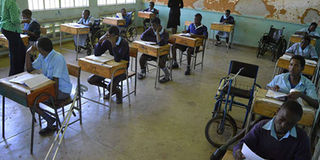Union wants over 10,000 teachers hired for special schools

Joyland Special Primary School Kenya Certificate of Primary Education candidates sit for their Kiswahili examination paper on November 1, 2017. Unionists want more teachers hired in special schools. PHOTO | FILE | NATION MEDIA GROUP
What you need to know:
- The National Treasury allocated Sh5 billion for the recruitment of 11,000 teachers for primary and secondary schools.
- In 2016, the Ministry of Education established a directorate to address the welfare of leaners with special needs.
A teachers' union wants the government to hire more than 10,340 new teachers for special schools because they are understaffed.
Kenya Union of Special Needs Education Teachers Secretary General James Torome said the recruitment of additional teachers will ensure that students get quality education.
"The government requires an estimated Sh124 million to hire the teachers," he said.
Special Schools Heads Association chairman Arthur Injenga supported Mr Torome, noting that the current human resource is not adequate.
"We are asking the Teachers Service Commission to give special allocation to these schools when recruiting teachers so that we are not lamped together with others," Mr Mr Injenga said.
ALLOWANCE
The National Treasury allocated Sh5 billion for the recruitment of 11,000 teachers for primary and secondary schools.
There are more than 300 special needs schools in the country.
This month, special allowance paid to teachers in these institutions by TSC was collapsed and consolidated with their salaries.
However, they will continue to get disability guide allowance of Sh15,000 per month.
DIRECTORATE
In 2016, the Ministry of Education established a directorate to address the welfare of leaners with special needs.
Statistics indicate that more than 100,000 children with disabilities are out of school nationwide.
A report by the Ministry of Education and Voluntary Services Overseas Jitolee, National Special Needs Education Survey, conducted in 2014 and released this year found that the physical infrastructure and resources in many schools are not suited to facilitate the needs of such learners.





